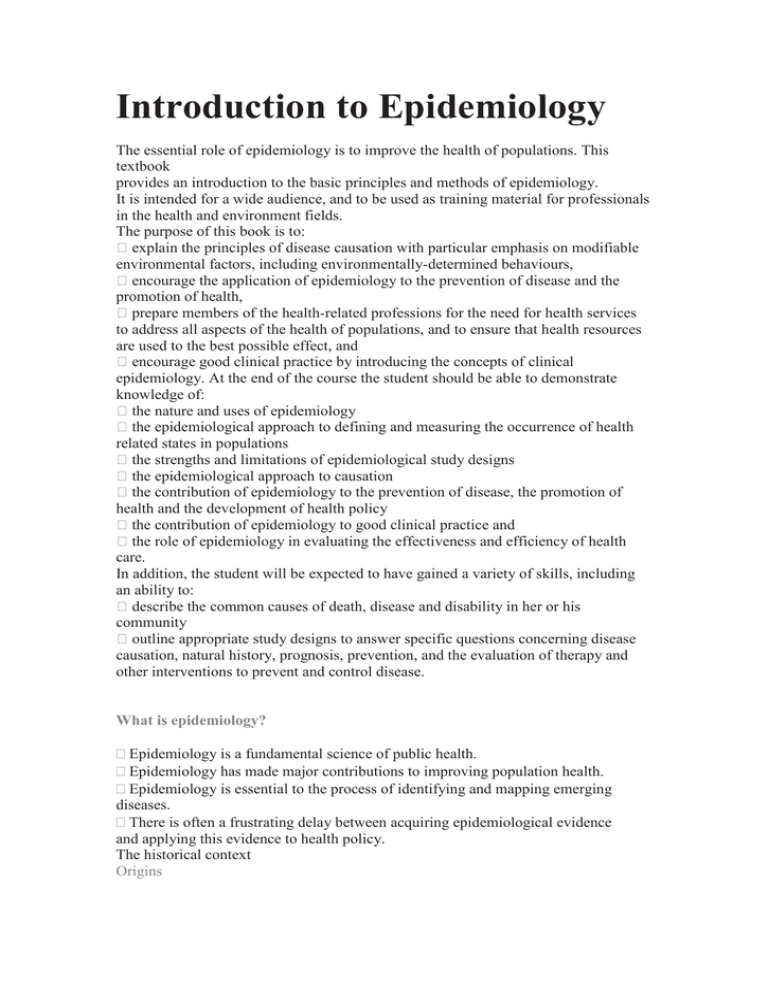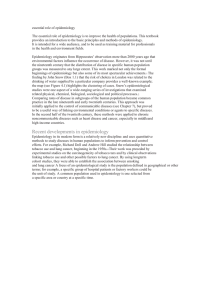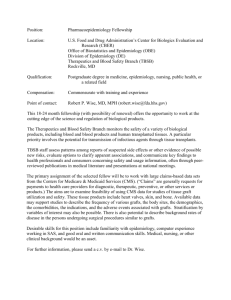Introduction to Epidemiology
advertisement

Introduction to Epidemiology The essential role of epidemiology is to improve the health of populations. This textbook provides an introduction to the basic principles and methods of epidemiology. It is intended for a wide audience, and to be used as training material for professionals in the health and environment fields. The purpose of this book is to: � explain the principles of disease causation with particular emphasis on modifiable environmental factors, including environmentally-determined behaviours, � encourage the application of epidemiology to the prevention of disease and the promotion of health, � prepare members of the health-related professions for the need for health services to address all aspects of the health of populations, and to ensure that health resources are used to the best possible effect, and � encourage good clinical practice by introducing the concepts of clinical epidemiology. At the end of the course the student should be able to demonstrate knowledge of: � the nature and uses of epidemiology � the epidemiological approach to defining and measuring the occurrence of health related states in populations � the strengths and limitations of epidemiological study designs � the epidemiological approach to causation � the contribution of epidemiology to the prevention of disease, the promotion of health and the development of health policy � the contribution of epidemiology to good clinical practice and � the role of epidemiology in evaluating the effectiveness and efficiency of health care. In addition, the student will be expected to have gained a variety of skills, including an ability to: � describe the common causes of death, disease and disability in her or his community � outline appropriate study designs to answer specific questions concerning disease causation, natural history, prognosis, prevention, and the evaluation of therapy and other interventions to prevent and control disease. Introduction xi xii Introduction What is epidemiology? Epidemiology is a fundamental science of public health. Epidemiology has made major contributions to improving population health. Epidemiology is essential to the process of identifying and mapping emerging diseases. There is often a frustrating delay between acquiring epidemiological evidence and applying this evidence to health policy. The historical context Origins Epidemiology originates from Hippocrates’ observation more than 2000 years ago that environmental factors influence the occurrence of disease. However, it was not until the nineteenth century that the distribution of disease in specific human population groups was measured to any large extent. This work marked not only the formal beginnings of epidemiology but also some of its most spectacular achievements. that the risk of cholera in London was related to the drinking of water supplied by a particular company provides a well-known example; the map highlights the clustering of cases. Snow’s epidemiological studies were one aspect of a wide-ranging series of investigations that examined related physical, chemical, biological, sociological and political processes.2 Comparing rates of disease in subgroups of the human population became common practice in the late nineteenth and early twentieth centuries. This approach was initially applied to the control of communicable diseases (see Chapter 7), but proved to be a useful way of linking environmental conditions or agents to specific diseases. In the second half of the twentieth century, these methods were applied to chronic Non communicable diseases such as heart disease and cancer, especially in middle and high-income countries. Recent developments in epidemiology Epidemiology in its modern form is a relatively new discipline1 and uses quantitative methods to study diseases in human populations to inform prevention and control efforts. For example, Richard Doll and Andrew Hill studied the relationship between tobacco use and lung cancer, beginning in the 1950s.4 Their work was preceded by experimental studies on the carcinogenicity of tobacco tars and by clinical observations linking tobacco use and other possible factors to lung cancer. By using long term cohort studies, they were able to establish the association between smoking and lung cancer .





